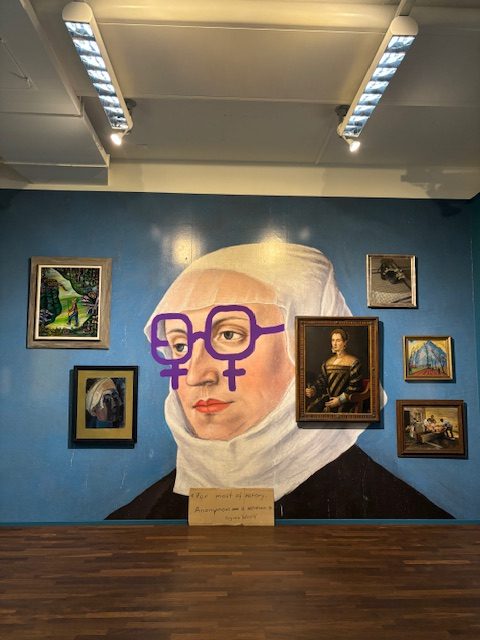The first thing Federico Fellini did on waking was to write down his dream, before it evaporated into irretrievable memory: his psychoanalyst had asked him to do so. Often, and over the course of thirty years, the late Italian maestro also sketched images from his dreams in a notebook that lay on the table by his bed. The recently published book of these amazing drawings and notes reveals that the cineaste, known for his outré (outlandish) imagination, transferred many of these nocturnal images to his films. Dreams were, time and again, a springboard for his creativity.

An image of Fellini foraging his dreamscapes for inspiration sprung to mind as I looked at the works from the large group exhibition, intriguingly titled ‘Lo Real Maravilloso – Marvelous Reality’. Magical realism is the overarching theme of the show curated by Sunil Mehra, journalist and writer on art. The exhibition celebrated twenty years of Gallery Espace and was on at Lalit Kala Akademi, Delhi, from December 9-11th, 2009. Most of the artists appear to have dipped into their fantasy worlds, even dreams and nightmares, in search of images and metaphors.
It’s an exciting – even bizarre mix of nearly 150 works from Indian artists as well those from overseas, including Albania, Iran, Latin America, Great Britain, Germany, the Indian diaspora. Clearly, many of them have explored their deeper selves – the parallel universe we inhabit in our dreams and reveries – and made manifest in their painting, sculpture, video, photography, collage, performance or installation. Elements of myth, memory, folklore, fairy tales, and comic books prevail in many of the works.
The roster is eclectic. It includes: rarely seen quirky sketches and paintings done by the late BhupenKakhar for his personal amusement, Bharti Kher’s sculpture of a naked woman-warrior with antlers sprouting from head, clad only in heels and seemingly caught between action and inaction, ChintanUpadhyay’s trees made of his signature baby heads and Jagannath Panda’s fibre glass sculpture of a looming male nude with a faux-tiger skin flung across his back with the head of a dog-like creature clawed paws attached to it: the man’s skin is made of a fine brocade.
“The concept of the show emerged after many discussions with Gallery director RenuModi.” says Mehrawhose brief to the artists was simple: I wanted the artists to acquaint themselves with their innerscapes, to reveal them and to explore their own landscape of meanings. I told them: ‘I have given you the diving board, now you create your own ripples.’ I didn’t circumscribe their imagination; rather I told them where I was coming from.” The curator was, in fact, coming from the realm of literature. He was re-reading the novels of the guru of magical realism, Gabriel Garcia Marquez, when he kept coming across works of art that echoed the Colombian writer’s world. Louise Gardiner’s ‘embroidered’ paintings, which he saw at the London Crafts Fair, reminded him of Marquez. “There was a young girl with butterflies coming out of her hair, ostriches and peacocks in a chaotic world.” And when the artist told him that she drove her “sewing machine like an Aston Martin”, he knew he had to include her in his show.
The quixotic universe of New York-based Rina Banerjee’spaintings and sculptures, the mythical symbolism of Tara Sabharwal’s whimsical watercolours, London-based Sutapa Biswas’s film installation of a horse in a living room, Manjunath Kamath’s rather surreal work with their quirky juxtapositions, amongst many others, convinced Mehra that he had to weave a show with art that ‘correlated’ with what he was reading.
Interestingly Mehra who is convinced that there are no boundaries between various forms of the arts – between literature, cinema, performing and fine arts – gave many of the artists’ books and DVDs of films which he felt had elements of magical realism in them. The films included MF Husain’s Meenaxi – Tale of Three Cities, Chocolate, Like Water for Chocolate, Ameli and Paheli.
The show has a catchy and layered title. Marvelous is not just something to marvel at: It also refers to the supernatural or miraculous. But for me many of these works of art can also comfortably fall under the category of surrealism. For example: GR Iranna’s canvases of performers, low-lying clouds and a fallen Greek statue and TanmoySamanta’s changeling hybrid creatures and Hello Love telephone, which is perhaps homage to Salvador Dali’s lobster telephone.
For Mehra, however, there is a clear distinction. “Surrealism goes into abnormal behavior and sexuality. It unites the subconscious and the unconscious. Magical Realism is at the cusp of the real and the imagined for me-the convergence of fantasy and coincidence in everyday life. We live in a parallel universe. We have an internal reality as potent as external reality.”
Image courtesy: Gallery Espace, New Delhi













